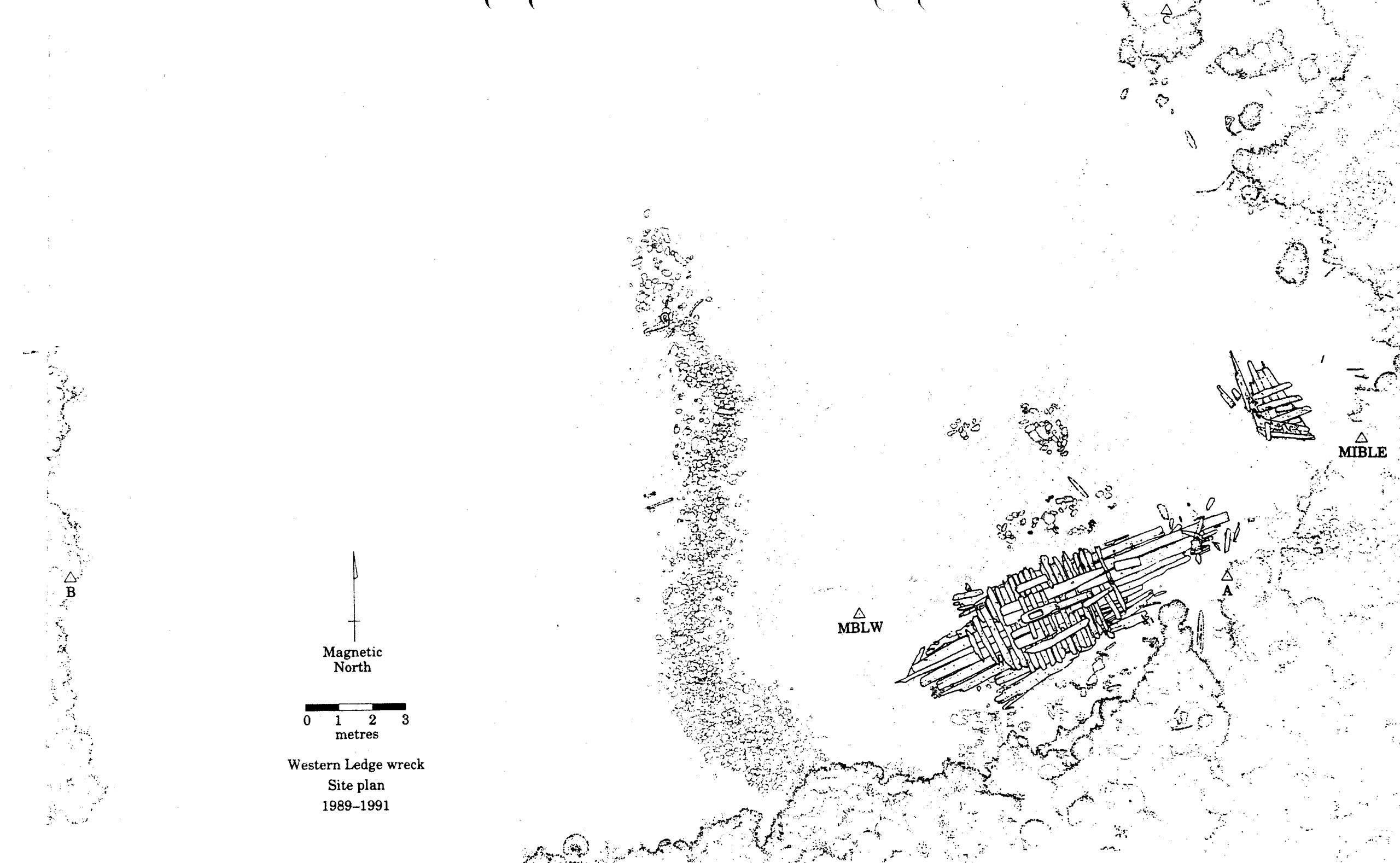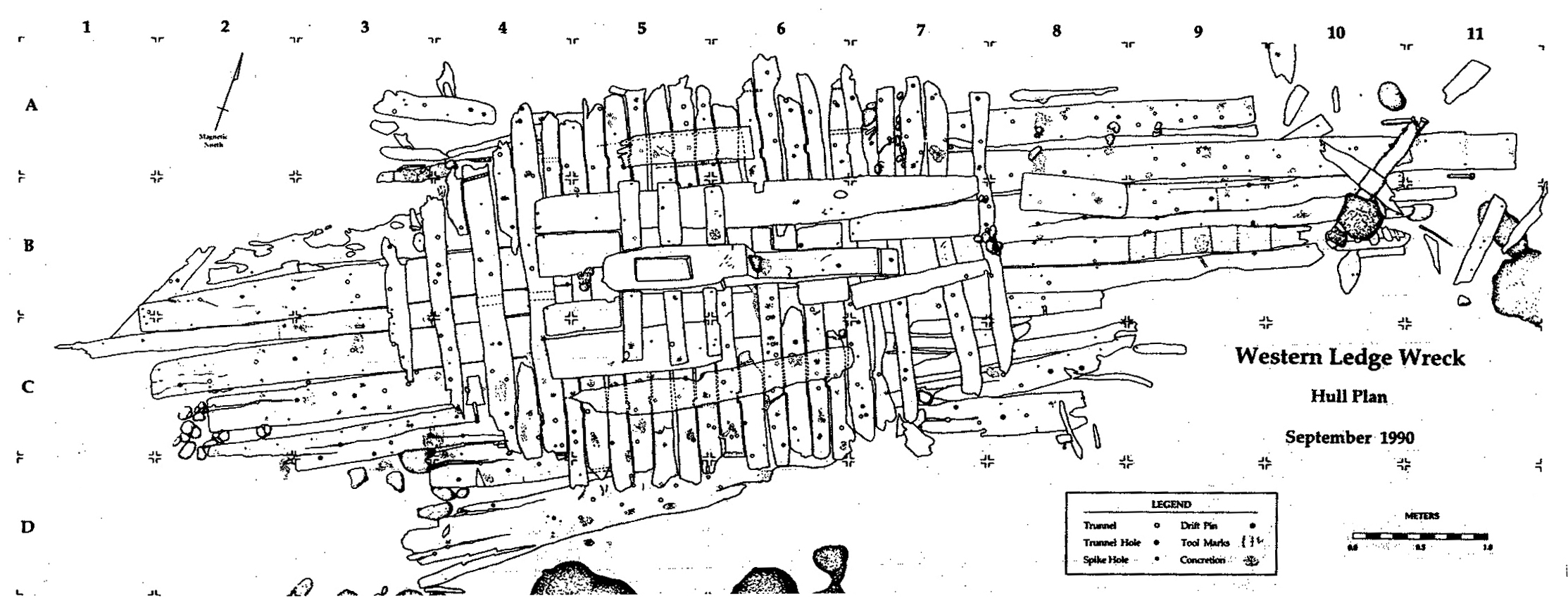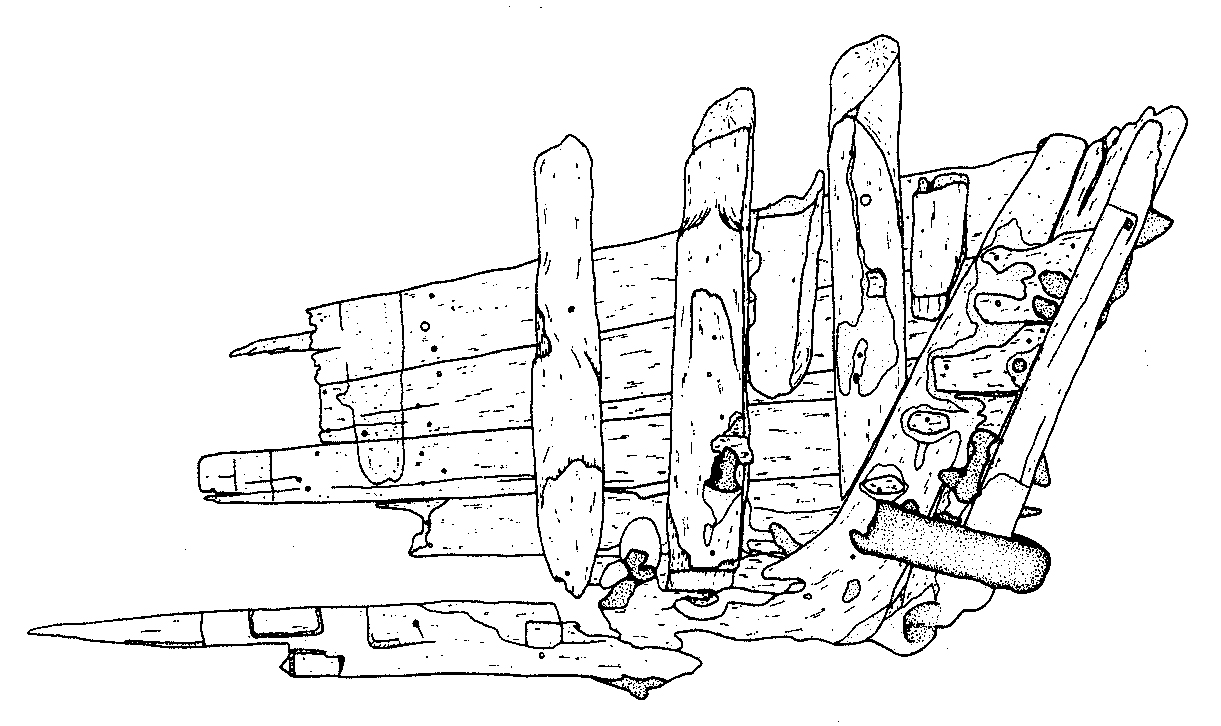Western Ledge Reef Wreck
Filipe Castro
History of the shipwreck
This wreck was found by treasure hunters in 1964 in the Western Ledge Reef, Bermuda, and salvaged intermittently until 1988, when a team from the East Carolina University identified the remains and managed to get a license to its excavation. It was excavated from 1989 to 1990 and the timbers recovered in 1991. It has not been identified although it was thought to be the Santa Lucia, wrecked in 1584.
In the early 2000s the ship’s timbers were studied by a Texas A&M student for his PhD dissertation (Bojakowsly 2012).
Description of the site
The remains of the hull were disturbed in the mid-1970s by Teddy Tucker an Mendel Peterson and are said to have first impacted the site.

As it was recorded by the ECU team, it was composed by three parts, the largest corresponding to the lower portion of the hull, preserved along 10.7 m, a second being the after portion of the keel and the lower portion of the stern post, and a third part believed to be a portion of the stern post.
Hull Remains
Keel, keelson, maststep and posts
Keel preserved along 9.1 m, from the stem. There was no rabbet and the lower face was rounded. At its after end was notched to fit Y-frames and scarfed to a couce.

Keelson preserved along 2.17 m, 20 cm sided and 17 cm molded, and showing an horizontal flat scarf at its after end. It was bolted to the keel through every 4th floor.
The maststep is an enlarged portion of the keel, 32 cm sided and cm molded. The mortise is 42 cm long, 17 cm wide and 14 cm deep. There were 3 buttresses on each side of the maststep.
A small piece of timber is believed to be part of the stem post (no more information).

Sternpost preserved in two parts. The lower seems to be a couce, is 20 cm sided and rakes 65º. It bears a rabbet. The second part is attached to a gudgeon and is 13 x 13 cm in section. It is attached to a stern knee with iron bolts.
Frames
The (single) midship floor is fastened to two pairs of futtocks, fore and aft, determining the framing pattern – the futtocks joined to the faces of the floors that look to the extremities of the ship. It is placed exactly below the forward end of the mortise of the maststep.

Fourteen floor timbers survived. It looks like the 6th floor timber abaft the master frame does not bear a dovetail scarf, suggesting that only 5 frames before and abaft the master frame were pre-assembled. The contemporary technical texts from this period suggest several recipes for the design of these ships’ frames, some with a different number of pre-designed frames before and abaft the master frame. The dovetails had the mortises on the floors, wide sides down, 15 mm deep. Twenty two futtocks survived, although no timber catalog seems to exist from this excavation.
Planking
The garboards were preserved, 35 cm wide and 4 cm thick. The rest of the planking 3.5 cm thick and 26-37 cm wide. Fastened with iron spikes and treenails.
Transom planking 4 cm thick, fastened at an angle of 27º to the sternpost.
Ceiling, thick stuff and wales
Three strakes, 3 cm thick, with a space in between the second and third strake suggesting the existence of a footwale.
Fastenings
Floors/keel: not specified. Keel/keelson: 1 bolt every 4th floor. Floors/futtocks: 1 treenail and 2/3 iron spikes. Planking/frames: iron spikes and treenails.
Caulking
No information.
Ballast
No information.
Size and scantlings
No information is given about the possible size of this vessel, although from the hull plan it seems that the midship frame (and the maststep) is 4.50 m abaft the forward most section of the keel, suggesting that this is a very small vessel with a keel of around 10 m and an overall length of around 15 m, for a beam of around 5 m.
| Sided (cm) | Molded (cm) | |
| Keel | ? | ? |
| Keelson | 20 | 17 |
| Maststep | 32 | ? |
| Sternpost | 20 | ? |
| Floors | ? | ? |
| Futtocks | ? | ? |
| Room-and-space | ? | – |
| Planking | 26-37 | 3.5-4 |
| Ceiling | ? | 3 |
Wood
Of six samples recovered for analysis five were oak and on birch, although no information is given about which pieces the samples represented.
Bibliography
Bojakowski, P., 2011. “The Western Ledge Reef Wreck: continuing research on the late 16th-/early 17th-century Iberian shipwreck from Bermuda,” in Post-Medieval Archaeology 45.1: 18–40.
Bojakowski, P., 2012. Western Ledge Reef Wreck: The Analysis and Reconstruction of the Late 16th-Century Ship of the Spanish Empire. PhD Dissertation. Texas A&M University
Watts, Gordon P., Jr “The Western Ledge Reef Wreck: a preliminary report on investigation of the remains of a 16th century shipwreck in Bermuda” IJNA (1993) 22.2 :103-124.
Watts, Gordon P., Jr “A preliminary description of the excavation, timber recording, hull contruction, and cultural material analysis of a 16th century vessel wrecked on Western Ledge Reef, Bermuda” Underwater Archaeological Proceedings from the Society for Historical Archaeology Conference, Tucson, Arizona, Ann Arbor, Michigan.
Watts, Gordon & Broadwater, John “Final report on IMHA-3: A Sixteenth-Century Spanish Wreck off Bermuda” Underwater Archaeological Proceedings from the Society for Historical Archaeology Conference, Vancouver, British Columbia, 1994, pp. 47-62.
